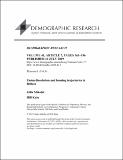Union dissolution and housing trajectories in Britain
Abstract
BACKGROUND A growing body of literature shows that divorce and separation have negative consequences for individuals’ residential mobility and housing conditions. Yet, no study to date has examined housing trajectories of separated individuals. OBJECTIVE We investigate housing trajectories of separated men and women using longitudinal data from Britain. METHODS We apply sequence analysis to data from 18 waves of the British Household Panel Survey (1991–2008). We use time since separation as the ‘clock’ in our analysis and examine the sensitivity of the results to attrition, the length of the observation window, and the choice of the classification criteria. RESULTS We identify five types of housing trajectories among separated individuals: ‘owner stayers’, ‘owner movers’, ‘social rent stayers’, ‘social rent movers’, and ‘private renters’. Men are more likely to stay in homeownership, whereas women are more likely to stay in social housing. There is an expected educational gradient; highly educated individuals are likely to remain homeowners, whereas people with low educational level have a high propensity to stay in or to move to social housing. Overall, this study shows that some individuals can afford homeownership after separation, and that social housing offers a safety net for the most vulnerable population subgroups (low-educated women with children). However, a significant group of separated individuals is unable to afford homeownership in a country where homeownership is still the norm. CONTRIBUTION This study shows that separation has long-term consequences for individuals’ housing conditions and that post-separation housing trajectories are significantly shaped by individuals’ socio-economic characteristics.
Citation
Mikolai , J & Kulu , H 2019 , ' Union dissolution and housing trajectories in Britain ' , Demographic Research , vol. 41 , 7 , pp. 161-196 . https://doi.org/10.4054/DemRes.2019.41.7
Publication
Demographic Research
Status
Peer reviewed
ISSN
1435-9871Type
Journal article
Description
The research for this paper is part of the project ‘Partner relationships, residential relocations, and housing in the life course’ (PartnerLife). Principal investigators: Clara H. Mulder (University of Groningen), Michael Wagner (University of Cologne), and Hill Kulu (University of St Andrews). PartnerLife is supported by a grant from the Netherlands Organisation for Scientific Research (NWO, grant no. 464–13–148), the Deutsche Forschungsgemeinschaft (DFG, grant no. WA 1502/6–1), and the Economic and Social Research Council (ESRC, grant no. ES/L01663X/1) in the Open Research Area Plus scheme.Collections
Items in the St Andrews Research Repository are protected by copyright, with all rights reserved, unless otherwise indicated.

